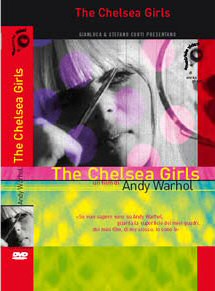|
Coming up with my favorite box sets from abroad is a far cry from
compiling a list of my favorite films on DVD, foreign or otherwise,
even if some of my favorite films are represented here. The problem
is, as Mick Jagger puts it, you can’t always get what you want. To
start with an extreme example, my favorite Hou Hsiao-hsien film is
most likely
The Puppetmaster (1993), but my
least favorite of all the DVDs of Hou films in my collection happens
to be the Winstar edition of that film. It’s so substandard—-not
even letterboxed, and packaged so clumsily--that I’m embarrassed to
find myself quoted on the back of the box, especially with the
quotation mangled into tortured grammar.
I’ve aimed for a certain geographical spread as well as some generic
balance: popular comedies, art films, experimental films, and one
serial; DVDs from Belgium, France, Hong Kong, Italy, Japan, and the
United Kingdom.
Admittedly, roughly half of my selections come from France, and a
quarter of them, to my surprise, comes from a single label, Gaumont—-maybe
because this blockbuster company seems to specialize in blockbuster
box sets. But it’s hard to think of artists more dissimilar than
Feuillade, Godard, and Guitry, so even here there’s pretty much of a
spread.
After much hesitation, I’ve decided to omit one awesome French box
set that lacks any sort of English translation—Alain Resnais’
Hiroshima mon amour (on Arte
Video)—even though I’ve unapologetically included another, Louis
Feuillade’s
Fantômas, as well as many
others that have a few untranslated features. But, just the same,
there are plenty of things that would make this missing item
delectable even if you don’t understand a word of French, such as
full-color reproductions of the letters, snapshots, and clippings
Resnais sent to screenwriter Marguerite Duras while scouting
Hiroshima locations, and three of Resnais’ major black and white
shorts. As a former Parisian who spent part of my film education
seeing many movies at the Cinémathèque Française without any sort of
translation, I can still recommend this activity over not seeing
some films at all.
The order of the list below is alphabetical, by title. I can’t
guarantee that all of these are still in print or available--some
are likely to be much harder to track down than others.
(NOTE: CLICK ON
TITLES, COVERS OR UNDERLINED TEXT FOR LINKS)

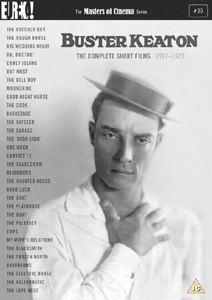
Compared to the Arte Vidéo boxset from France
HERE |
1)
Buster Keaton: The Complete Short
Films, 1917-1923
(Masters
of Cinema, four discs + 184-page booklet)
If you want a definitive edition of what some critics
have called the purest examples of Keaton’s comedy, look
no further. (James Agee, for one, wrote that “for plain
hard laughter,” the Keaton shorts are even better than
the features.) One of these early shorts--Moonshine
(1918), codirected by “Fatty” Arbuckle--is incomplete,
but the 31 other restorations are all intact, and
they’re a joy to behold. And the accompanying book gives
us, along with many illustrations, generous extracts
from Keaton’s autobiography and several interviews as
well as an extended critical roundtable on Keaton by
three top-notch critics, Jean-Pierre Coursodon, Dan
Sallitt, and Brad Stevens. Regrettably, I’ve only had
room on this list for one set from the superb Masters of
Cinema--an English series distributed by Eureka! that
also offers essential works by
Michelangelo Antonioni,
Fritz Lang,
Jean-Pierre Melville,
Kenji Mizoguchi,
F.W. Murnau,
Mikio Naruse,
G.W. Pabst,
Luchino Visconti,
and
Orson Welles, among
many others—-but if you’ve never seen an example of
their work, this release should provide an excellent
introduction. |
|
 |
|
2)
Chantal Akerman Collection: Les
Années 70/De Jaren ‘70
(Cinéart, five discs)
Please note that this is the Belgian as opposed to the
French set devoted to Chantal Akerman’s most radical
period, an edition supervised by the filmmaker
herself--which is the only one that has optional English
(as well as Flemish) subtitles. The films included, all
digitally remastered, are her two earliest shorts,
Saute ma ville (1968) and La Chambre (1972),
and her first five features--Hotel Monterey
(1972), Je Tu Il Elle (1975), Jeanne Dielman,
23 Quai de Commerce, 1080 Bruxelles (1975),
News from Home (1976), and Les Rendez-vous
d’Anna (1978). |
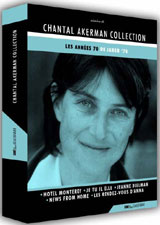 |
The extras are quite remarkable —-in most cases, major additions to
Akerman scholarship: recent long conversations between Akerman and
Babette Mangolte (her cinematographer on Jeanne Dielman),
Aurore Clément (her lead actress in Les Rendez-vous d’Anna),
and her mother Nathalia; a short 1996 interview with Akerman taken
from the French TV documentary Chantal Akerman by Chantal Akerman;
and, best of all, a feature-length 1975 documentary about the making
of Jeanne Dielman, including some fascinating video footage of
Akerman working with the title star, Delphine Seyrig. (This was made
during a period when video reportage of this kind was still in its
infancy, so the image quality here is fairly primitive and
rough-hewn, but the interest of the content more than makes up for
it.).
|
 |
|
|
3)
The Chelsea Girls: un film di Andy
Warhol (Minerva Video, two discs + 66-page
bilingual booklet)
The challenge here was how to transport Andy Warhol’s
most commercial experimental feature to DVD without
losing its most essential aspects. Shot in 16 millimeter
between June and September 1966, the film consists of a
dozen reels adding up to 394 minutes or about six and a
half hours. But, as projected, the film lasts only half
that long, 197 minutes, because it’s designed for
simultaneous double-screen projection, usually with one
reel projected with sound and the other reel projected
silently.
|
How shifting or fixed the arrangement of reels is
supposed to be is a matter of some dispute. According to Warhol
critic Peter Gidal, “color film is projected on the left,
black-and-white on the right,” and “the two projectors are not
synchronized and therefore at each showing the left screen image
and the right screen image correspond differently.” According to
Stephen Koch in another book about Warhol, “Tradition, rather
than Warhol himself, has established the standard sequence of
reels,” and according to Jonas Mekas, who established precise
split-screen projection instructions, reel #2 on the left is
supposed to start five minutes after reel #1 on the right, and
the stretches of silence or sound or the occasional sound mixes
between two reels are all predetermined.
The letterboxed version offered here seems to strike a rough
compromise between these various versions. In a few cases we see
a particular diptych twice, enabling us to hear the sound of
each reel in turn while the adjacent reel runs silent. (There
are 16 chapters in all.) There’s also a second disc of extras
that includes Mekas’s 1982 Scenes from the Life of Andy
Warhol, a 2003 dialogue between Mekas and Paul Morrissey,
and three additional bits of English-subtitled commentary by
pontificating Italians—-Enrico Ghezzi, Mario Zonta, and Achille
Bonitao Oliva. (Ghezzi, in homage to Warhol, speaks in a
split-screen himself!)
|
 |
|
4)
Coffret Charles Chaplin 10 DVD
(mk2 éditions/Warner Video, ten discs)
Why, you may ask, include the French edition of this
remarkable package when it’s also available as a
region-1 set in the U.S.? Because a great deal of care
and attention went into the French set, and the
differences count.
Both versions, of course, include all of Chaplin’s
features apart from The Countess from Hong Kong
(the last and least of them), as well as the seven
shorts comprising The Chaplin Revue, and also
many remarkable extras, such as commentaries by other
directors about individual Chaplin films—-most notably,
the Dardenne brothers on
Modern Times,
Claude Chabrol on
Monsieur Verdoux,
and Jim Jarmusch on
A King in New York.
So this is obviously a box set worth having in any form.
But it’s more worth having if the packaging allows you
to appreciate what’s there. |
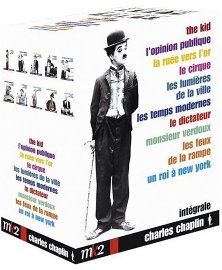 |
Consider the handling of a fascinating extra that’s
included with Chaplin’s 1923
A Woman of Paris—-an
elaborate, half-hour amateur film of 1926, a spoof called
Camille, made in New York by one Ralph Barton and probably
featuring more famous people on both sides of the Atlantic (over
50 of them, in fact) than any other home movie ever made. This
was at the height of Prohibition, so there are loads of gags
about people getting soused. The title heroine is played by
Anita Loos, the flapper author of Gentlemen Prefer Blondes,
and prominent parts are also taken by her director husband John
Emerson as well as Chaplin (who performs an encore of his famous
Dance of the Rolls from The Gold Rush); other prominent
actors include Paul Robeson, Ethel Barrymore, and Dorothy Gish.
The French edition of the DVD includes an elaborate guide to who
plays whom and when—-enabling us to discover, for instance, that
speakeasy owner Gas House Charlie is played by Theodore Dreiser,
Sherwood Anderson is the “ruined archeologist,” H.L. Mencken is
a Prohibitionist and Clarence Darrow is a Prohibition agent.
Sinclair Lewis plays the allegorical figures Love, Hate,
Despair, Adultery, and Greed, while Alfred A. Knopf, in costume
and makeup, is Abdul-el-Hamman, a white slave trader—-none of
which we’re likely to figure out if we have only the U.S.
edition to go by, where the packagers couldn’t care less about
any of this.
Perhaps my favorite extra on any DVD appears on the region-1 DVD
of D.W. Griffith’s
Orphans of the Storm
(1921). It’s a radio eulogy for Griffith delivered by Erich von
Stroheim when Griffith died, and it ends with Stroheim bursting
into tears. Imagine how diminished this speech might be if Kino
Video had decided that it didn’t matter who delivered the
speech, and therefore didn’t bother to mention it. That’s the
kind of treatment we get on the American edition of this box
set.
|
 |
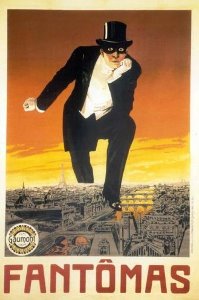 |
5)
Fantômas
(Gaumont, two discs + 32-page booklet)
For me, the most enjoyable movies made by anyone during
the teens are the French serials made for Gaumont by
Louis Feuillade--especially
Fantômas
(1913-1914),
Les vampires
(1915-1916),
Judex (1917), and
Tih Minh (1919). (Barrabas, which he made just after the
teens, in 1920, is also quite wonderful.) Tih Minh,
my favorite, hasn’t yet made it onto DVD, even though
it’s been restored, but both
Les vampires and
Judex are available
in fine editions in the U.S.
Fantômas is
available in both France and the U.K., in editions that
appear to be similar (the cover design is the same), but
I can’t vouch for this, because I have and treasure only
the French version. (Artificial Eye, the distributor of
the English version, has generally been reluctant to
send me review copies of their releases, unlike the
British Film Institute, Masters of Cinema, and Second
Run. According to English Amazon, their edition has the
same running time as the French, but I don’t know if it
has all of the same extras.) |
Properly speaking,
Fantômas isn’t a serial in the
same way the others are, because it consists of five feature-length
episodes rather than ten or a dozen short episodes, and some of these are
relatively independent of one another. (Their source is a series of
32 extremely popular novels by Marcel Allain and Pierre Souvestre
that started appearing in 1911.) But insofar as these episodes
follow the exploits of a master criminal who goes under various
disguises and has a secret gang, Fantômas clearly offers a prototype
that the subsequent Feuillade serials would draw from in various
ways.
The fabulous Gaumont box set has almost as many tricks up its sleeve
as Fantômas himself. Go to the first menu on either disc, and after
you hear a footsteps and a key unlocking a squeaky door in the
darkness, three closed doors appear, asking you to choose one. Five
of these six doors stand for separate episodes; the sixth leads to
further extras. Then the following menu in the first five cases
presents you with a room containing a desk, with half a dozen
objects to choose from with your remote control--objects that are
near the desk or on top of it or inside one of the drawers. One of
the items on top of the desk is a reel of film, which leads you into
the episode itself (beautifully tinted, with an effective orchestral
score); all the others lead you into various hidden bonuses. (My
favorite of these is a bit of magical footage that shows you
Fantômas morphing through the spectrum of all his secret identities,
within a few seconds; some of the others are short texts or period
illustrations relating to the novels.).
|
 |
|
6)
Histoire(s) du cinema (Gaumont,
four discs) (Cinefil Imagica, five discs;
www.cinefilimagica.com)
I have two separate editions of Jean-Luc Godard’s
intransigent and beautiful magnum opus. The first
one that appeared is the second one cited above, and the
most expensive box set I’ve ever purchased from
anywhere—even though it’s boxed fairly modestly, like a
set of CDs. It has better sound and image, and an
amazing feature that enables you to reference any moment
in this eight-part video with your remote control,
leading you to a citation (of the film a clip comes
from, the name of an artwork, and perhaps even the
source of each verbal quotation). The only glitch, and
it’s a major one, is that this feature is all in
Japanese, and the only optional subtitles available on
this Japanese set are also in Japanese. In fact, I’m not
even sure if the URL cited above will take you to this
set. (For that, you’re probably better off going to the
Japanese branch of Amazon. - Ed. see
HERE) |
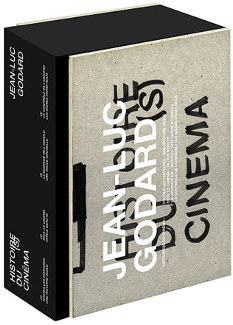 |
The Gaumont version, on the other hand, has optional
English titles, though these are relatively spare, focusing
basically on the same portions of the text that Godard has
published in various languages in books included with the
soundtrack of
Histoire(s) du cinema on
CDs. As I’ve pointed out before on this site (HERE),
there is no completely satisfactory way to subtitle this
multilingual work, especially because no one, including French
speakers, can follow all of it, and even trying to translate
most of what gets said or printed would itself create an
impenetrable jungle for us to navigate. So this version is
pretty acceptable, although it’s a pity that Gaumont didn’t take
the trouble of subtitling any of the extras, which include
Godard and Anne-Marie Miéville’s feature-length 2 X 50 Ans du
Cinéma Français and two separate press conferences at
Cannes, in 1988 and 1997—apart from French subtitles to the
portions of the 1988 press conference that are in English. By
the way, there’s a third version of
Histoire(s) du cinema,
again with English subtitles, that Artificial Eye is supposed to
be bringing out soon (HERE),
if it hasn’t done so already.
|
 |
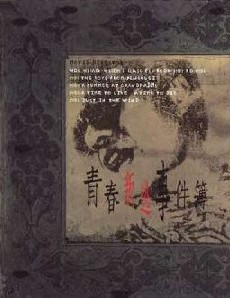 |
7)
Hou Hsiao-Hsien’s Classics
from 1983 to 1986 (Sino Movie, four discs + copiously
illustrated 52-page booklet in Chinese with some foldout
pages)
Some of my choices here are partly inflected by the
degree to which some box sets qualify as beautiful
objects. This is certainly the case with this gorgeous
and compact collection from Hong Kong, containing The
Boys from Fengkuei (1983), A Summer at Grandpa’s
(1984), A Time to Live A Time to Die (1985), and
Dust in the Wind (1984)—to quote the four titles
just as they’re written on the box encasing the elegant
fold-out container. All these films are impeccably
letterboxed and furnished with optional English
subtitles, so I couldn’t care less that the menus, apart
from the films’ English titles, are all in Chinese. This
is still very user-friendly, and the booklet attached to
the foldout container, like the color illustrations on
the discs themselves, is a pleasure even when one can’t
read the words. |

|
8)
Orson Welles’ Macbeth
(Wild Side Video, three discs + 80-page booklet in
French)
Macbeth may be my least favorite among Orson
Welles’ three feature-length Shakespeare films, with
neither the mystery of his
Othello nor the
human majesty of his
Chimes at Midnight.
But when it comes to a definitive DVD edition of any
Welles film, I don’t think there’s any contest. This has
everything you’d ever want to have: both versions of the
film (released respectively in 1948 at 114 minutes and
in 1950 at 85 minutes; both, one should stress, are
Welles cuts, even though the second one was occasioned
by Republic Pictures asking him for a redubbed and
shortened version); a newsreel recording of the last
four minutes of Welles’ 1936 “Voodoo” Macbeth,
staged in Harlem (which is the only sound-film record
that we have of any Welles stage production); and the
full 78-minute audio version of the play done for 78 RPM
records in 1940, with a cast of Mercury Theatre players
and a Bernard Herrmann score)—all of which is impeccably
restored. Then there’s more than an hour of additional
extras that are in unsubtitled French, although the
illustrations in some cases are likely to hold your
interest. Most of these are discussions done separately
by Jean-Pierre Berthomé and François Thomas, the two
foremost French Welles scholars--whose excellent and
very up-to-date book,
Orson Welles at Work,
which they wrote together, was published in English
translation earlier this year.
|
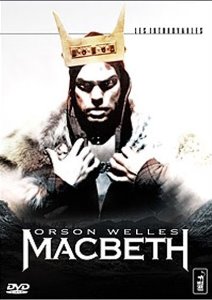 |

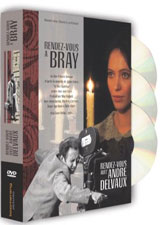 |
9)
Rendez-vous à Bray
(Boomerang Pictures, two DVDs + one CD + 88-page
paperback novel in French, Julien Gracq’s Le Roi
Cophetua, + 36-page bilingual booklet in French and
Flemish)
This is surely the most obscure item here, but it’s such
a lovely film—-made in Belgium in 1972--and it receives
so much loving care from the friends of the late
writer-director André Delvaux that it deserves to be
much better known. For one thing, it’s surely one of the
most erotic films ever made, featuring both Anna Karina
and Bulle Ogier at their most attractive. For another,
it’s steeped in nostalgia for more or less the same era
when Louis Feuillade’s serials were being made. |
|
Try to imagine a quiet blend of
Jules and Jim and
Gertrud filmed in
color (the cinematographer is the great Ghislain Cloquet,
who also did superb work for Demy, Bresson, Polanski,
and Penn)and you’ll start to get some idea of the mood
of this adaptation of a novella by post-surrealist
writer Julien Gracq. Most of it charts a mysterious
night in 1917 spent by a Luxembourgian pianist and music
journalist (Mathieu Carrière) who’s been summoned by a
friend, a soldier and composer (Roger van Hool), to his
house in a Paris suburb. The friend inexplicably never
appears, but the woman (Karina) who prepares dinner,
whose identity is never clarified, eventually takes him
to bed. There are also several flashbacks involving the
two friends as well as the soldier’s girlfriend (Oger),
a character who doesn’t exist in Gracq’s story.
Most of this box set, an exquisite labor of love, is in
French, Flemish/Dutch, and English-—prepared with
Delvaux’s input just a few weeks before his death.
Philippe Raynaert’s graceful 24-minute intro spells out
the contents, designed to show Delvaux’s close
involvements with painting, music, literature, and
cinema. All of these are evident in the feature,
explicated in Raynaert’s lecture, and further
represented, respectively, by Delvaux’s half-hour
With Dieric Bouts (1975); his 20-minute Moviola
(1985) about Frédéric Devresse (a composer he often
collaborated with) plus a CD with music (including
Brahms and Franck) and dialogue from the film; the Gracq
story, published with a preface by Gracq about Delvaux;
and Delvaux’s seven-minute 1001 Films (1989),
dedicated to Jacques Ledoux, the former director of the
Belgian Cinémathèque. (Delvaux used to perform piano
accompaniments to silent films there—-as the hero of
Rendez-vous is seen doing in one of the flashbacks,
at a commercial screening of
Fantômas, no less.)
There are also a couple of TV documentaries about the
film’s production from the 70s. |

|
10)
Sacha Guitry L’Age d’or 1936-1938
(Gaumont, eight discs)
By far the heftiest piece of merchandise being
considered here, this is a big box containing no less
than nine features on eight discs, which is all the more
remarkable when one considers that
writer-director-actor-personality Sacha Guitry-yet
another celebrity who turns up in the silent Camille
included in the Chaplin box set--made all these films
between 1938 and 1939! I haven't yet been able to
determine whether he was also doing any theater during
the same two-year stretch, but even if he wasn't, one
certainly couldn't fault him for being unproductive.
For the record, the nine features included here, all
provided with optional English subtitles, are Le
Nouveau Testament, Le Roman d’un tricheur
(many critics’ favorite), Mon Père avait raison,
Faisons un Rêve, Les Perles de la Couronne
(my own favorite, at least among those I’ve seen so far,
and, as a trilingual wonder that unfolds almost
simultaneously in French, English, and Italian, a
genuine tour de force), Le Mot de Cambronne,
Désiré, Quadrille, and Remontons les
Champs-Elysées. There are also loads of extras, all
unsubtitled, including interviews with such filmmakers
as Olivier Assayas, Jacques Rivette, Eric Rohmer, and
François Truffaut. |
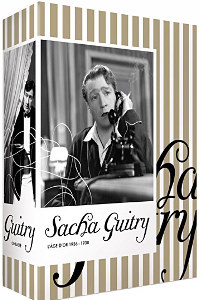 |
When I ordered this set last Christmas, my reasoning was
that I was about to retire from my 20-year stint at
The Chicago Reader
and therefore would have plenty of time to plow my way
through this collection, improving my French in the
process. Now it’s half a year later, and I find that
I’ve become far too busy writing articles like this one
to even make a proper start. But hope springs eternal.

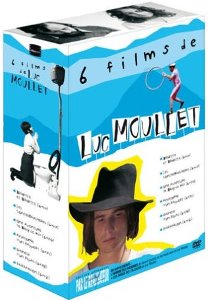 |
11)
16 Films de Luc Moullet
(Blaqout, four discs)
Luc Moullet remains one of the great, undiscovered
glories of French comic cinema as well as one of the key
Cahiers du Cinéma
critics who became a filmmaker (and, unlike virtually
all his colleagues, is still a film critic today). But
he’s always stood apart from his fellow critics as well
as his fellow filmmakers—-as a left-wing anarchist,
proud of his working-class and rural background (and
still keenly interested in some Hollywood directors
associated with the right, such as Cecil B. De Mille,
Josef von Sternberg, and King Vidor); as the only
Cahiers critic who
defended Luis Buñuel in the 50s, before he became
fashionable; as a minimalist director whose aesthetics,
economics, and ethics have always been closely
interrelated; and as an occasional deadpan actor in his
own post-Keaton, post-Tati comedies. It’s typical of
what might be called his radical modesty that even the
title of this director-approved collection is inexact;
there are actually eight films here, at least if one
counts the two short features comprising the fourth
disc, both counted as bonuses—-Moullet’s The Sieges
of the Alcazar (1989) and Gérard Courant’s The
Man of the Badlands (2001) a documentary about
Moullet. |
|
The official six are Brigitte et Brigitte (1966),
Les contrebandières (1967), Une Aventure de
Billy le Kid (1970), Anatomie d’un rapport
(1975), Genèse d’un repas (1978), and
Parpaillon (1992). All eight of these have optional
English subtitles except for Billy le Kid--a
crazed western starring Jean-Pierre Léaud and seemingly
inspired by both
A Duel in the Sun
and a fever dream—-and in that case, Moullet includes
his own English version of the film, A Girl is a Gun.
These are just about all of Moullet’s major features.
(The sole exception is his 1987
La Comédie du travail—already
released separately by Blaqout, unfortunately without
any subtitles.) They include even his best noncomedy,
his 1978 Origins of a Meal, a powerful political
documentary that tells you where three simple food
staples come from. An even more ideal box set would
include Moullet’s best shorts--three of which are
available elsewhere on DVD (at least if you look very
hard), in separate collections, again without subtitles;
and, to cite Agee on Keaton, “for plain hard laughter,”
these are even better than the features. But this
collection is still a nearly perfect introduction to his
work. (If you want to explore some of these films
separately, Facets Video has issued them in pairs on
single region-1 discs. Ed. see
HERE)
I’d recommend starting out not with Courant’s
documentary but with The Sieges of the Alcazar--a
sweet and hilarious tale of a sexual grudge match in the
50s between a male
Cahiers du Cinéma
critic and a female leftist critic for the rival
magazine Positif, which takes place at a small
neighborhood cinema playing a Vittorio Cottafavi
retrospective. You might even call it a
A Duel in the Sun
writ small. Apart from offering loads of badly dubbed
clips and the theme song from
Rio Bravo over the
credits, this appears to be a near-definitive account of
the rituals and agonies of French cinephilia during that
period. |

|
12)
Le vent nous emportera
(The Wind Will Carry Us) (MK2 éditions, two
discs)
Here’s something else you can readily find in the U.S.;
New Yorker Video offers a ho-hum version of it. But I’m
mainly listing this French double-disc edition of my
favorite Abbas Kiarostami feature (1999), his last to
date to be shot on 35-millimeter, with optional English
subtitles on everything, because of the two
documentaries it includes on the second disc—A Film
Lesson by Abbas Kiarostami, 52 minutes long, and,
even more, Yuji Mohara’s 90-minute A Week with
Kiarostami, which in some ways is the most
informative and revealing “making of” documentary I’ve
ever seen. And this two-disc set is the only place I’m aware
of where you can find it. |
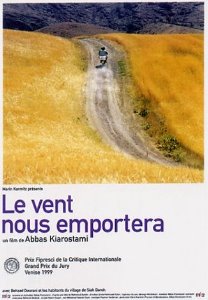 |
|



